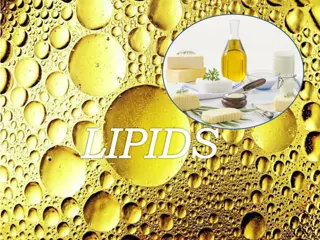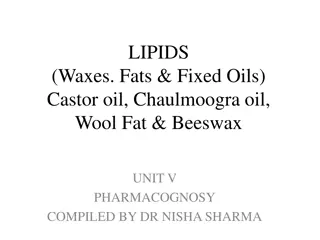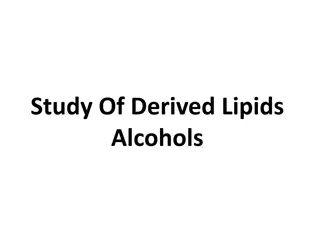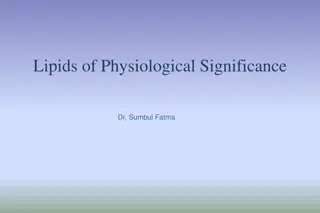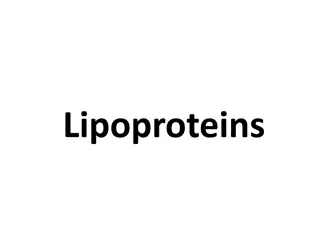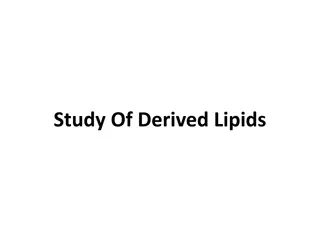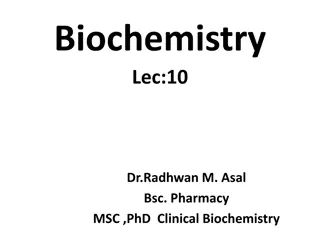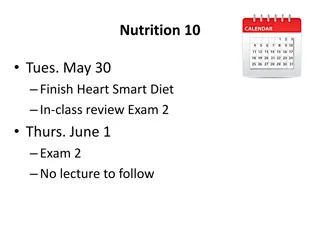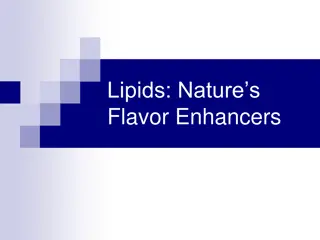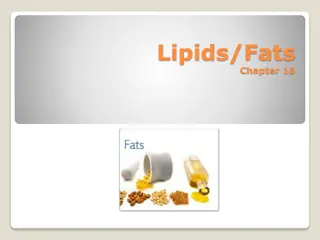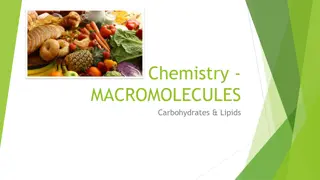Understanding Lipids: Properties, Functions, and Structure
Lipids are diverse organic compounds vital for metabolism and cell functions. They are insoluble in water, serve as energy sources, aid in hormone synthesis, and form cell membranes. Fatty acids, the building blocks of lipids, provide fuel for the body. Saturated fatty acids have high melting points and are solid at room temperature, while unsaturated fatty acids are liquid. Essential fatty acids like omega-3 and omega-6 are crucial for human nutrition, found in sources like seed oils.
Download Presentation

Please find below an Image/Link to download the presentation.
The content on the website is provided AS IS for your information and personal use only. It may not be sold, licensed, or shared on other websites without obtaining consent from the author. Download presentation by click this link. If you encounter any issues during the download, it is possible that the publisher has removed the file from their server.
E N D
Presentation Transcript
Lipids Lipids are a large and diverse group of naturally occurring organic compounds that share some general properties.
General Properties of Lipids 1. Insoluble in water. 2. Soluble in non-polar organic solvents e.g. ether, acetone,.. 3. Contain carbon, hydrogen, and oxygen; sometimes contain nitrogen and phosphorus. 4. On hydrolysis they give fatty acids. 5. Take part in plant and animal metabolism.
Functions of Lipids 1. Energy storage, mobilization, and utilization. 2. Cell differentiation and growth. 3. Cell membrane structure. 4. Signal transmission. 5. Hormone synthesis. 6. Bile acid synthesis.
Fatty Acids Fatty acids are the building blocks of lipids; they are straight-chain organic acids. All fatty acids have an even number of carbon atoms. Fatty acids are important sources of fuel because, metabolized, they yield large quantities of ATP. Many cell types can use either glucose or fatty acids for this purpose. In particular, heart and skeletal muscle prefer fatty acids
Structure of Fatty Acids Fatty acids consist of one carboxyl group (-COOH) attached to a non-polar hydrocarbon tail. General Formula: CH3(CH2)n -COO- Saturated Fatty Acids Non-Saturated Fatty Acids
Types of Fatty Acids I- Saturated fatty acids: Contain only single bonds between carbon atoms. Have high melting points. At room temperature they are fats (solid form). II- Unsaturated fatty acids: Contain one or more double bonds between carbon atoms. Have low melting points. At room temperature they are oils (liquid form). They are subdivided into: Monounsaturated (one double bond) and Polyunsaturated (many double bonds) fatty acids.
Essential Fatty Acids Fatty acids which are essential for the complete nutrition of the human body. There are twenty different needed fatty acids in your body, but they are all made from two: - Linoleic acid (omega-6 fatty acid) found in seed oils like corn, peanut, cotton seeds,.. - Linolenic acid (omega-3 fatty acid) found in seed oils like soybeans, walnuts,..
These two fatty acids are essential. You must get them from the foods you eat because your body cannot manufacture them. Thus, essential fatty acids are the building blocks for all the other fats in your body. Linoleic acid and Linolenic acid essential fatty acids are especially important for making prostaglandins (hormone) in your body. They also play a role in controlling your blood pressure, your heart, your kidneys, your digestive system, and body temperature. They are important for allergic reactions, blood clotting and making other hormones.
Classification of Lipids Lipids are divided into three main types: 1. Simple. 2. Complex. 3. Precursor & derived lipids.
I- Simple Lipids Simple lipids are esters of fatty acids. When hydrolyzed they yield fatty acids and alcohol. If the simple lipid yield 3 fatty acids and glycerol it is called: fat or oil. If the simple lipid yield one fatty acid and high molecular weight alcohol it is called: wax.
II- Complex Lipids When hydrolyzed they give (yield) one or more fatty acids, an alcohol, and other compounds. Examples of Complex Lipids: Phospholipids, Glycolipids, and lipoproteins.
III- Precursor and Derived Lipids Precursor lipids Precursor lipids are compounds produced when simple and complex lipids are hydrolyzed to produce fatty acids, glycerol, and other alcohols. Derived lipids Derived lipids are formed by metabolic transformation of fatty acids to steroids, ketone bodies, lipid-soluble vitamins,.. e.g:Prostaglandins, Steroids,..
Simple Lipids: FATS AND OILS Triglycerides Triglycerides (TAG, Triacylglycerol) are major form of fat stored by the body. A triglyceride consists of three molecules of fatty acid combined with a glycerol. Triglycerides come from the food we eat as well as from being produced by the body
Triglycerides Glycerol 3 Fatty Acids FAT (TAG)
Triglycerides TAG that contains one type of fatty acid is called simple TAG, whereas TAG that contains 2 or 3 types of fatty acids is called mixed TAG. Fatty acids forming TAG can be saturated, unsaturated, or a combination.
Uses of Fats in the Body 1. Energy source: fats produce more than double the energy produced by proteins and carbohydrates. 2. Storage: a mean to store food in the body for energy and to protect internal organs. 3. Keeps our bodies warm in cold weather. 4. Present in cell structure and nerve tissues.
Physical Properties of Fats and Oils 1. Pure fats are generally white solids and oils are generally yellow liquids. 2. Tasteless and odorless. 3. Fats and oils are insoluble in water but are soluble in organic liquids like benzene, acetone,.. 4. Do not pass through membranes. 5. Are lighter than water.
http://t3.gstatic.com/images?q=tbn:ANd9GcQgTO8sOlpPxjz8uYbdWSobYhcZgdJMfVmMdbKKK_wyr0AIEhK8Si_BtJQhttp://t3.gstatic.com/images?q=tbn:ANd9GcQgTO8sOlpPxjz8uYbdWSobYhcZgdJMfVmMdbKKK_wyr0AIEhK8Si_BtJQ http://t1.gstatic.com/images?q=tbn:ANd9GcSz2DCjKZRjNTLHKewZl8eX4ba-HbyNBdSCohM8PICo4SC2IL181qsGuA oil Fat oils are insoluble in water http://t0.gstatic.com/images?q=tbn:ANd9GcTJz_LOzT3jV0hfCgxbi7e3w48pBbDpSGNO9sAugDjXt3K1MQzL4AtlzGs oils are lighter than water
Chemical Reactions of Fats 1. React with Iodine. 2. Hydrolysis. 3. Saponification. 4. Hydrogenation. 5. Rancity.
I- Reaction with Iodine Unsaturated fats and oils will react with Iodine but saturated fats and oils will not.
II- Hydrolysis Fats will hydrolyze (break down) to form glycerol and free fatty acids when they are treated with enzymes, acids, or bases. 3
III- Saponification Saponification is the heating of a fat with a strong base (e.g. NaOH or KOH) to produce glycerol and the salt of fatty acid. The Na or K salts of a fatty acid are called Soaps. Heat FAT + NaOH or KOH Soap
VI- Hydrogenation Hydrogenation is the process of converting vegetable oils to fats by the addition of hydrogen in the presence of a catalyst. In this process some but usually not all of the double bonds in oils have been reduced by the addition of H2e.g.Margarine.
Hydrogenation Margarine
V- Rancidity When fats are left at room temperature for a short period of time they develop unpleasant odor and taste i.e. they become Rancid. This occurs due to 2 reactions: oxidation and hydrolysis of fat.
Complex Lipids: PHOSPHOLIPIDS Structure of Phospholipids Phospholipids are complex fat in which one fatty acid has been replaced by phosphoric acid (phosphate group) and one of several nitrogen-containing molecules. Phospholipids are found in all tissues in the human body, especially brain, liver, and spinal tissue and also in cell membranes.
When hydrolyzed they give (yield) one or more fatty acids, an alcohol, and other compounds
Types of Phospholipids According to the alcohol part, phosphospholipids are divided into: 1. Phosphoglycerides: contain glycerol. E.g. Lecithin, cephalins. 2. Phosphosphingosides: contain sphingosine. E.g. sphingomyelins.
Properties of Phospholipids Amphipathic: Amphipathic lipids are molecules that have non-polar (hydrophobic) end or tail and a polar or ionic (hydrophilic) end or head.
Complex Lipids: GLYCOLIPIDS They are sugar containing lipids also called cerebrosides because they are found in large amounts in the brain tissue. Structure of Glycolipids Glycolipids are composed of one fatty acid, one sphingosine molecule, and a galactose sugar. There are many types depending on the type of fatty acid present.
Complex Lipids: LIPOPROTEINS Lipoproteins are lipids associated with special proteins to give plasma lipoproteins. Examples of Lipoproteins Chylomicrons: 90% lipids and 10% protein. Very Low Density Lipoproteins (VLDL): 60% lipids and 40% protein. Low Density Lipoproteins (LDL): 8% lipids and 92% protein. High Density Lipoproteins (HDL): 5% lipids and 95% protein.
The Cell Membrane Cell membranes are composed of 40-50% lipids, 50-60% proteins, cholesterol, and a small amount of carbohydrate. These components vary in amounts depending on the type of cells. Functions of the Cell Membrane 1. Give structure and protection to the cells. 2. Hold up proteins that transport molecules across the cells.


